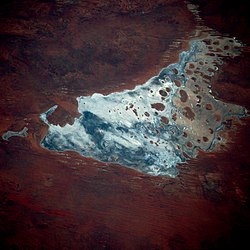Life

Sources differ on the year of Syddick's birth. The Art Gallery of South Australia suggests 1941; [1] Birnberg and Kreczmanski's biographical survey suggests circa 1937. [2] The ambiguity around the year of birth is in part because Indigenous Australians operate using a different conception of time, often estimating dates through comparisons with the occurrence of other events. [3] She was born near Western Australia's Wilkinkarra, or Lake Mackay, [2] northeast of Kiwirrkurra Community, Western Australia and northwest of Kintore, Northern Territory.
'Napaljarri' (in Warlpiri) or 'Napaltjarri' (in Western Desert dialects) is a skin name, one of sixteen used to denote the subsections or subgroups in the kinship system of central Australian Indigenous people. These names define kinship relationships that influence preferred marriage partners and may be associated with particular totems. Although they may be used as terms of address, they are not surnames in the sense used by Europeans. [4] [5] Thus 'Linda Syddick' is the element of the artist's name that is specifically hers. Syddick has also been referred to as Tjungkaya Napaltjarri, [6] however she is not the artist Tjunkiya Napaltjarri, who lived at Papunya, Northern Territory.
Syddick's parents were Wanala [2] or Napulu [6] Nangala and Rintja Tjungurrayi; however Rintja (or Riintja) was killed in a revenge attack when Syddick was still very small, [6] and in 1943 her mother moved to Kintore. [7] Syddick's stepfather Shorty Lungkarta Tjungarrayi was a significant influence on her early painting. [2] Short Lungkata was also the father of artist Wintjiya Morgan Napaltjarri (known as Wintjiya No. 2 and no relation to yet another artist, Wintjiya Napaltjarri). [8] Linda married Musty Siddick, had two children Ruby and Irene, and in the 1970s they were living in a Northern Territory Pintupi community called Yayayi. [6] After Musty's death she remarried. [9]
Syddick has also achieved recognitition as a painter's model: she was the subject of Robert Hannaford's painting that was a finalist in the 2002 Archibald Prize, Australia's premier portrait prize. [10]